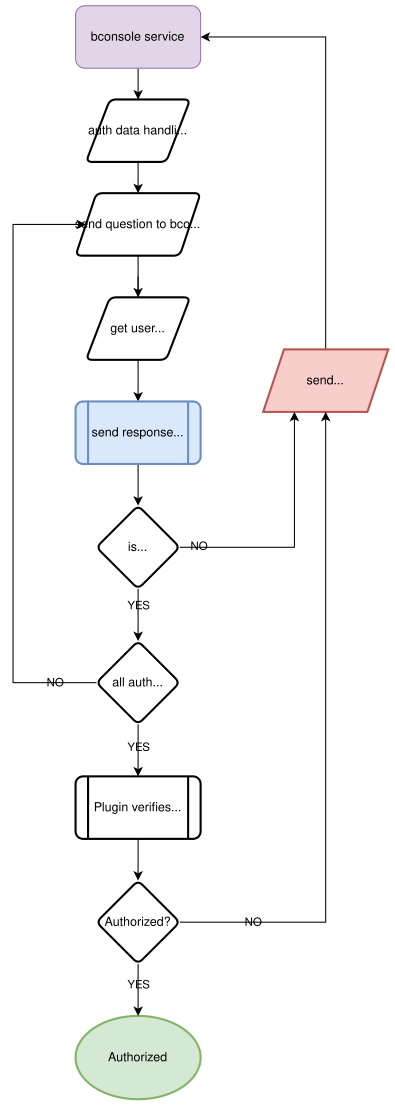bacula-dir.conf - Console Resource Configuration
The entry point getPluginAuthenticationData() is called when
Director needs to forward authentication to selected <plugin> which
is defined with Authentication Plugin = ... parameter. The name
<plugin> has to match the filename of the Director plugin (without a
-dir.* suffix). No other plugin will be bothered. The function takes
the following parameters:
- param
is a
nulterminated string defined on the right side of the parameter, including plugin name and optional plugin parameters.- data
is a pointer to
bDirAuthenticationRegisterstruct pointer (bDirAuthenticationRegister**) which should be filled as a return value for plugin data registration.
The bDirAuthenticationRegister structure is defined as:
typedef struct s_bDirAuthenticationRegister {
const char * name;
const char * welcome;
const uint32_t num;
const bDirAuthenticationData *data;
const int32_t nsTTL;
} bDirAuthenticationRegister;
which together with bDirAuthenticationData structure will define a
full authentication workflow managed by this plugin. Where parameters
are:
- name
is a name of the authentication plugin and should match the
<plugin>string in Console resource configuration.- welcome
is an optional authentication welcome string which will be displayed before first authentication question.
- num
is a number of elements in authentication operation data table pointed by
databelow.- data
the pointer to the authentication operation data (
bDirAuthenticationData) table, the first element, with a number of elements defined innumabove.- nsTTL
currently unimplemented, for future usage.
The structure bDirAuthenticationData is defines as:
typedef struct s_bDirAuthenticationData {
const bDirAuthenticationOperation operation;
const char * question;
const uint32_t seqdata;
} bDirAuthenticationData;
where:
- operation
a single authentication step (operation) which should be performed by Director + bconsole application. The list of possible operations include: display user the message, get login from user, get password from user, etc.
- question
the
nulterminated string to display to the user during credentials collection.- seqdata
32 bit integer for full plugin use; this value will be added to the user response send to the plugin.
Both bDirAuthenticationRegister and bDirAuthenticationData
structures could be a statically compiled data or assembled in runtime.
Director will read data from it and never change. BPAM defines the
following authentication operations:
typedef enum {
bDirAuthenticationOperationPlugin,
bDirAuthenticationOperationPluginAll,
bDirAuthenticationOperationMessage,
bDirAuthenticationOperationPlain,
bDirAuthenticationOperationLogin = bDirAuthenticationOperationPlain,
bDirAuthenticationOperationHidden,
bDirAuthenticationOperationPassword = bDirAuthenticationOperationHidden,
bDirAuthenticationOperationAuthenticate,
} bDirAuthenticationOperation;
- bDirAuthenticationOperationPlugin
Director will get the current operation from the plugin using
bDirEventAuthenticationQuestionplugin event, then it should execute the operation returned.- bDirAuthenticationOperationPluginAll
Director will get all authentication operations from the plugin with
bDirEventAuthenticationQuestionplugin events loop.- bDirAuthenticationOperationMessage
Director will ask bconsole to display a message pointed by
bDirAuthenticationData.questionand will proceed to the next operation in the list.- bDirAuthenticationOperationPlain
(alias
bDirAuthenticationOperationLogin) Director will ask bconsole to display a message pointed bybDirAuthenticationData.question, then get plain input visible to the user and proceed to the next operation in the list.- bDirAuthenticationOperationHidden
(alias
bDirAuthenticationOperationPassword) Director will ask bconsole to display a message pointed bybDirAuthenticationData.question, then get hidden (*) input invisible to the user, i.e. a password, and proceed to the next operation in the list.- bDirAuthenticationOperationAuthenticate
tells Director to finish all user interaction and asks plugin for authentication using
bDirEventAuthenticateplugin event.
Every authentication operation of bDirAuthenticationOperationPlain
and bDirAuthenticationOperationHidden will return with an user
response data which will be forwarded directly to plugin using
bDirEventAuthenticationResponse plugin event. No other operations
will do that. During this event a plugin is responsible to save user
response as it won’t be saved by Director and lost forever. These
collected responses should be used for final user authenticate. The
response is passed to plugin with bDirAuthValue.response variable
and filled with seqdata value from current question operation.
As soon as the number of questions (authenticate operations) defined
during registration (the bDirAuthenticationRegister.num value) comes
to the end or one of the operation executed is
bDirAuthenticationOperationAuthenticate then Director will stop
asking a user more questions and will generate the
bDirEventAuthenticate plugin event. During this event handling a
plugin is responsible to verify all responses and perform user
authentication.
There is a special operation in BPAM:
bDirAuthenticationOperationPluginAll which tells Director to asks in
runtime the plugin for every single operation to execute. This allow to
build a dynamic authentication procedure with a variable number of
questions and challenges. In this case a plugin is responsible to
explicitly finish a workflow with
bDirAuthenticationOperationAuthenticate.
You can find below some examples for above structures.
static bDirAuthenticationData testquestions0[] =
{
// operation; question; data;
{bDirAuthenticationOperationLogin, "Username:", 0},
{bDirAuthenticationOperationPassword, "Password:", 1},
};
static bDirAuthenticationRegister testregister0 =
{
.name = "PLUGIN_NAME",
.welcome = "This is a test authplugin API Plugin. Use root/root to login.",
.num = 2,
.data = testquestions0,
.nsTTL = 0,
};

Figure 3.1: BPAM General Workflow
Above you can find a simplest user/password authentication scheme with plain (visible) user input and hidden (invisible) password input.
static bDirAuthenticationData testquestions1[] =
{
// operation; question; data;
{bDirAuthenticationOperationLogin, "Username:", 0},
{bDirAuthenticationOperationPlugin, NULL, 1},
{bDirAuthenticationOperationPlain, "Response:", 2},
};
static bDirAuthenticationData testquestions1_msg =
{
// operation; question; data;
bDirAuthenticationOperationMessage, NULL, 0
};
static bDirAuthenticationRegister testregister1 =
{
.name = "PLUGIN_NAME",
.welcome = "This is a test authplugin API Plugin. Use bacula username to login.",
.num = 3,
.data = testquestions1,
.nsTTL = 0,
};
Above you can find a simplest MFA (challenge-response) authentication scheme with out of band authentication verification. In this example a plugin will display a message prepared in runtime by plugin.
Possible Next Steps
Go back to Bacula FD Plugin API.
Go back to Developer Guide.